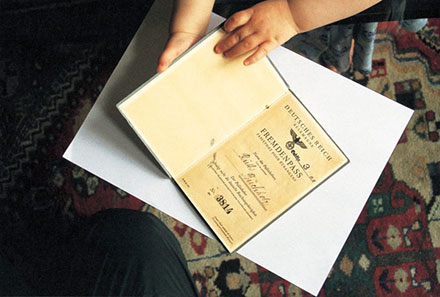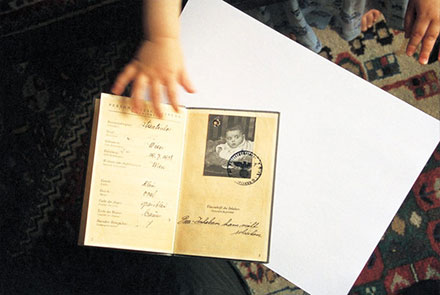Article by Anthony Auerbach first published with German translation by Bettina Steinbrügge in Lasso, No. 1 (Lüneburg: Halle für Kunst/Frankfurt am Main: Revolver, 2004) pp. 88–92 (German), pp. 151–153 (English), reprinted in Klub Zwei, in Zusammenarbeit mit, edited by Annette Südbeck (Vienna: Secession, 2005), pp. 34–39.
Things.Places.Years.
Things.Places.Years. is a film about women I know by women I have gotten to know; a film about women I have grown up with in London—women to whom I owe my education—by women who have grown up and were educated in Germany and Austria. It is a film about the knowledge of Jewish women. That is, getting to know Jewish women and getting to know what Jewish women know. The film records a process of coming to terms with the knowledge of an absence: the absence through which the past makes itself present in a city such as Vienna.
I first met Klub Zwei (Simone Bader and Jo Schmeiser) when they came to London in 2000 to begin researching a project then without a name. They did not introduce themselves as documentary film-makers. They introduced me to a collaborative art practice focused on the interrogation of women’s experience and an approach to media in which forms of representation—graphics, video, text—are understood as interventions in public space, that is, as interventions in a public discourse rather than in a supposedly autonomous art discourse. Klub Zwei’s (then) most recent project Work on/in Public (Arbeit an der Öffentlichkeit, 1999), developed in co-operation with MAIZ (an autonomous centre run by and for migrant women) in Linz, Austria, resulted in a series of posters based on interviews with women from various parts of the world who had recently settled in Austria. The women’s remarks on the present-day legal, social and political condition of immigrants in Austria came to be seen in a sharper light, especially outside Austria, after the success of Jörg Haider’s far-right Freedom Party in the 2000 general election. One of the poster headlines reads, in the words of one the women, ‘Austria never got over the Hitler era.’
 Passport of Jewish girl born in Vienna
in 1938 / held by her granddaughter in
2001 / photographed by Klub Zwei
Passport of Jewish girl born in Vienna
in 1938 / held by her granddaughter in
2001 / photographed by Klub ZweiThe initial motivation of Klub Zwei’s research in London was to follow up their previous work by investigating the heritage of emigration from Austria, that is, the presence in London of women, their daughters and granddaughters, who had escaped—some only narrowly—from the genocidal persecution of Jews during the Nazi period. Jo and Simone were particularly interested to meet women whose work involved them in the cultural sphere: in the production, transmission and preservation of knowledge. It soon became clear that this could be no objective documentation. It would be a conversation which examined not only the émigré condition, and the experience of the Holocaust, but also Klub Zwei’s own position, in their words, ‘as descendants of the perpetrator society.’ The project would establish its structure on the axis Vienna-London, not by focusing exclusively on Jewish women born in Austria, but by talking about women’s experience of the city. The twelve women with whom Klub Zwei recorded interviews come from diverse geographical and religious backgrounds and would never conceive of themselves as a group. Things.Places.Years. asks us to reflect on what these women might share, alongside the fact that by chance or by design they have made their homes in London. That is, to reflect on the construction of identity: what it means when we identify ourselves or are identified by others as women, as Jews, as migrants, as bearers or curators of a culture or a historical experience.
In the interviews, history is refracted through the women’s family stories: through their relationships with people, places, things. However, it becomes clear that for many of the women, these stories were not discussed in the family. Ruth Sands describes how, if ever her father mentioned their life before emigration, whenever he began ‘Bei uns in Wien ...’ (‘At home in Vienna ...’), her mother would interrupt angrily, ‘Es gibt nichts zu sagen.’ (‘There is nothing to say about it.’) She says of her mother: ‘She left Vienna and she was, I think, thirty-three and it was as if her life started when she was thirty-three.’ Ruth Sands also tells how she attempted to protect her own children by not discussing the family history. The acknowledgement of this reluctance is echoed in different ways by several of the women. Yet for all the women, there is no question that the history which has marked their families in various ways is something that should be known. One may also say that all the women recognise the desire and the right of the next generation to know. In Klub Zwei’s conversation with Elly Miller and her daughter Tamar Wang, Tamar questions her mother and remarks how it was almost as if she had never heard it before; how her sense of history was never a family story, or at least that the family story was only ever pieced together from things mentioned occasionally in the home and intermingled with fragments of the bigger picture of history that was taught outside the home. Elly Miller makes the point that her own childhood recollections are also coloured by the knowledge, acquired only later, of the monumental horrors which now seem to stand at the centre of Europe’s twentieth century. Hearing my mother Geraldine Auerbach speak to Klub Zwei and reflect, for example, on her father’s family’s journey from Lithuania to South Africa at the turn of the twentieth century, her upbringing there under the regime of ‘separateness’ (apartheid) and her joy in the diversity (the mixed-up-ness) of a city such as London, was to hear things I know, but only vaguely—family things—expressed in an unfamiliar way. My mother prefers, perhaps, to express what this heritage means to her through her work as founder and director of the Jewish Music Institute. This also suggests something about another of Klub Zwei’s questions: about the women’s sense of Jewish identity.
 Passport of Jewish girl born in Vienna
in 1938 / held by her granddaughter in
2001 / photographed by Klub Zwei
Passport of Jewish girl born in Vienna
in 1938 / held by her granddaughter in
2001 / photographed by Klub ZweiThe crossing of history, identity and work also emerges in what we learn of Ruth Sands’s co-operation in the Second Generation Trust, an organisation founded by Katherine Klinger. The organisation was started as a way of ‘bringing out into the open the generational consequences of history,’ specifically for the post-Holocaust generation, the generation for which the Holocaust is nonetheless, as Katherine Klinger put it to Klub Zwei, ‘part of an unseen and unexpressed trauma.’ However, the Second Generation Trust does not focus only on how it has affected the descendants of the survivors [1], but includes the children of perpetrators, collaborators and so-called bystanders. Is the history from which Ruth Sands derives her sense of Jewish identity the same as that which makes Jewish identity, for Katherine Klinger, hard to grasp? Is the historical ‘rupture’ which is the topic of the Second Generation Trust’s activities echoed in the cultural displacement felt by immigrants and their children? Do we value these displacements as historical reminders, that is, the vectors of a history on which an identity might be founded, even if a broken one? Is Jewish history (and hence identity) unique in being founded, it seems, on displacement and remembrance?
Things.Places.Years. does not attempt to extract a consensus from the women’s statements, nor impose one on it, nor is it a history lesson. It is a film, that is, an intervention by Klub Zwei. The film accepts the severity of cutting many hours of interviews to seventy minutes. It suggests the telling of history as a form of interrupted speech, remembrance as interruption in the present. The cut permits the viewer to listen as if the women would speak for one another, and so, their differences in experience, in expression, in opinion, emerge as an equivocality in the identity we have projected on them. The cut works because of Klub Zwei’s consistent attentiveness: on a single page such as the poster Bei uns in Wien, on many pages such as the book Things.Places.Years. The Knowledge of Jewish Women (which forms an extensive record of Klub Zwei’s conversations and from which I have quoted), in five minutes of voice and text such as Schwarz auf Weiss or in seventy minutes of interruption documenting the presence of absence.
Anthony Auerbach
Los Angeles, January 2004
Note
- This is the focus of the Second Generation Trust. Many of the survivors lost their parents, thus they are the children of the ‘victims’ (A common childhood experience of the second generation was that it was always other people who had grandparents). But the identification ‘victim’ can be problematic. The phrase ‘victims of the Holocaust’ perhaps falsely dignifies their fate. To acknowledge that the grandparents were murdered by the Nazis could be more to the point. [back to text]
References
Things. Places. Years.
(2004, DV-CAM, colour, 4:3, stereo,
70 min, English with German subtitles)
a film by Klub Zwei (Simone Bader & Jo Schmeiser)
Things. Places. Years. The Knowledge of Jewish Women
(2004, 300pp, 140 x 202 mm, English and German)
a book by Klub Zwei (Simone Bader & Jo Schmeiser)
Bei uns in Wien/At home in Vienna
(2002, 594 x 841 mm)
posters by Klub Zwei (Simone Bader & Jo Schmeiser)
Österreichischer Grafikpreis, Innsbruck, 2002
with: Geraldine Auerbach, Josephine Bruegel, Erica Davies, Lisbeth
Perks, Katherine Klinger, Elly Miller, Rosemarie Nief, Anni Reich,
Ruth Rosenfelder, Ruth Sands, Nitza Spiro, Tamar Wang
Schwarz auf Weiss—Die Rückseite der Bilder
(2003, Mini-DV, B&W, 4:3, stereo, 5 min, Polish, French, Bulgarian,
English and German)
a video by Klub Zwei (Simone Bader & Jo Schmeiser) with Rosemarie Nief